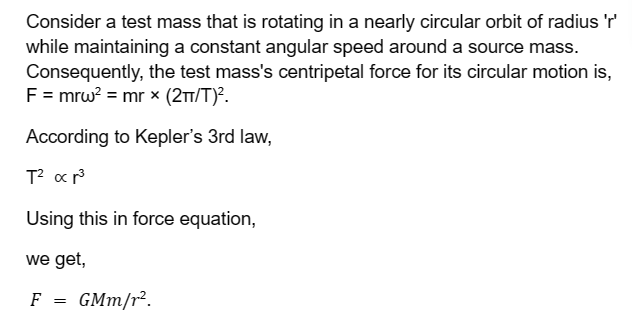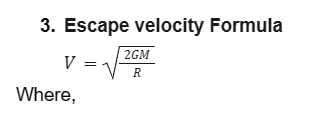
Gravitational Force Formula : The introduction of the concept of gravitation in physics marked a significant turning point in our understanding of the fundamental forces that govern the behavior of objects in the universe. The movements of planets, stars, galaxies, and even common phenomena we encounter on Earth are all a result of gravitation.
What Is Gravitational Force?
The movements of planets, stars, galaxies, and even common phenomena we encounter on Earth are all a result of gravitation, the force of attraction that exists between all masses in the universe. It is responsible for the interaction between all objects in the universe that have mass, from tiny particles to planets, stars, galaxies, and beyond.Newton’s Law of Gravitation In Gravitation Formula
Newton's Law of Gravitation, formulated by Sir Isaac Newton in 1687, is one of the fundamental pr F = G (m1 m2) / r 2 inciples of classical physics. It describes the gravitational force between two objects with mass and is applicable to a wide range of everyday and astronomical scenarios. The law states that every particle of matter in the universe is drawn to one another by a force that is directly proportional to the product of their masses and inversely proportional to the square of the distance between their centres. Mathematically, this law is expressed as: F = G (m 1 m 2 )/ r 2 Where:- The gravitational force between two objects is denoted by f .
- G is the gravitational constant (a fundamental constant of nature),
- m 1 and m 2 are the masses of the two objects,
- The separation between the centres of the two objects is known as r.
Also Check - Kinematics Formula
Vector Form of Newton’s Law of Gravitation
Newton's law of gravitation describes the force of gravitational attraction between two objects with masses m 1 and m 2 , separated by a distance r . The vector form of Newton's law of gravitation is given by: g=−GMr/r 3 (point mass). Where, r is where the test point lies in relation to the mass M.Also Check - Rotation Motion Formula
Gravitational Force Formula
The gravitational force formula, as described by Isaac Newton's law of universal gravitation, is given by: F = G(m 1 m 2) / r 2 Where,- The gravitational force (F), which is measured in Newtons (N), between two objects.
- G is the universal gravitational constant with a value of 6.674 × 10 -11 Nm 2 kg -2 .
- M 1 is the mass of one massive body measured in kg.
- The mass of another enormous body, measured in kg, is m 2 .
- The distance between them, r, is expressed in kilometres (Km).
Also Check - Friction Formula
Principle of Superposition of Gravitational Forces
The principle of superposition states that when you have multiple masses in a system, the gravitational forces between them act independently of each other. In other words, the total gravitational force on a given object is the vector sum of the individual gravitational forces exerted by all the other masses in the system. Mathematically, if you have three masses (m 1 , m 2 , and m 3 ) at different positions, the total gravitational force (F_total) on one of the masses, say m1, due to the other two masses can be calculated as: F total = F 12 + F 13 , Where:- F 12 is the gravitational force between m 1 and m 2 ,
- F 13 is the gravitational force between m 1 and m 3 .
Also Check - Resultant Force Formula
Using Kepler's Law to derive Newton's Law of Gravitation ,

Important Formula’s
- Orbital Velocity Formula
 Where,
G = Gravitational Constant
M = Mass of the Body at Centre
R = Radius of the Orbit
Where,
G = Gravitational Constant
M = Mass of the Body at Centre
R = Radius of the Orbit
- Gravitational Potential Energy Formula
 Where,
Where,
- V is the escape velocity
- G is the gravitational constant
- M is the mass of the planet
- R is the radius from the center of gravity
Gravitational Force Formula FAQs
What is gravitation?
Objects with mass are drawn to one another by the basic force of nature known as gravity. It is in charge of the weight phenomenon and the movement of celestial objects like planets, stars, and galaxies.
Who discovered the law of gravitation?
The law of universal gravitation is said to have been created by Sir Isaac Newton in the late 17th century. His hypothesis states that every mass will gravitate towards every other mass with a force directly proportional to the sum of their masses and inversely proportional to the square of their separation.
What is the value of the gravitational constant (G)?
The gravitational constant (G) is approximately equal to 6.67430 x 10-11 N(m/kg)2. It is a fundamental constant that determines the strength of the gravitational force between objects.
Is there zero gravity in space?
In space, astronauts and objects are still subject to gravitational forces, but they experience a sensation of weightlessness because they are in freefall around a massive body (like Earth). This creates a continuous state of falling, which gives the illusion of zero gravity.
🔥 Trending Blogs
Talk to a counsellorHave doubts? Our support team will be happy to assist you!

Check out these Related Articles
Free Learning Resources
PW Books
Notes (Class 10-12)
PW Study Materials
Notes (Class 6-9)
Ncert Solutions
Govt Exams
Class 6th to 12th Online Courses
Govt Job Exams Courses
UPSC Coaching
Defence Exam Coaching
Gate Exam Coaching
Other Exams
Know about Physics Wallah
Physics Wallah is an Indian edtech platform that provides accessible & comprehensive learning experiences to students from Class 6th to postgraduate level. We also provide extensive NCERT solutions, sample paper, NEET, JEE Mains, BITSAT previous year papers & more such resources to students. Physics Wallah also caters to over 3.5 million registered students and over 78 lakh+ Youtube subscribers with 4.8 rating on its app.
We Stand Out because
We provide students with intensive courses with India’s qualified & experienced faculties & mentors. PW strives to make the learning experience comprehensive and accessible for students of all sections of society. We believe in empowering every single student who couldn't dream of a good career in engineering and medical field earlier.
Our Key Focus Areas
Physics Wallah's main focus is to make the learning experience as economical as possible for all students. With our affordable courses like Lakshya, Udaan and Arjuna and many others, we have been able to provide a platform for lakhs of aspirants. From providing Chemistry, Maths, Physics formula to giving e-books of eminent authors like RD Sharma, RS Aggarwal and Lakhmir Singh, PW focuses on every single student's need for preparation.
What Makes Us Different
Physics Wallah strives to develop a comprehensive pedagogical structure for students, where they get a state-of-the-art learning experience with study material and resources. Apart from catering students preparing for JEE Mains and NEET, PW also provides study material for each state board like Uttar Pradesh, Bihar, and others
Copyright © 2025 Physicswallah Limited All rights reserved.
Get App









